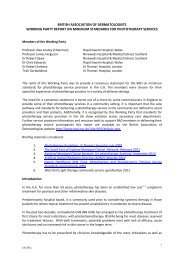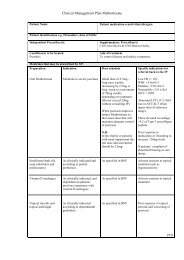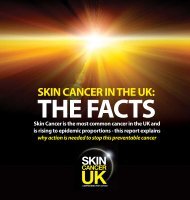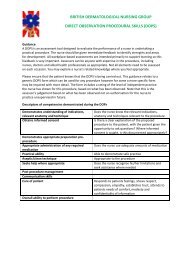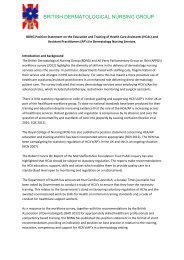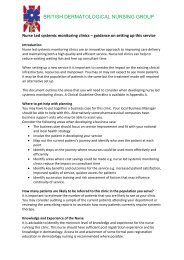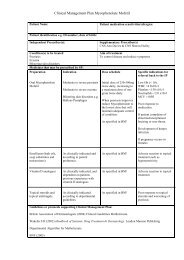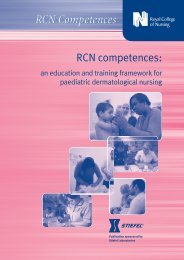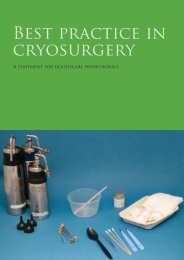Improving outcomes for people with skin tumours including melanoma
Improving outcomes for people with skin tumours including melanoma
Improving outcomes for people with skin tumours including melanoma
You also want an ePaper? Increase the reach of your titles
YUMPU automatically turns print PDFs into web optimized ePapers that Google loves.
Genetic predisposition to MM may also occur, <strong>with</strong> approximately<br />
1–5% of patients <strong>with</strong> MM having a family history. Rare high-risk<br />
genes occur that are inherited as autosomal dominants, and these may<br />
manifest as multiple primary <strong>tumours</strong> in an individual and/or<br />
clustering in families. Most families <strong>with</strong> these genes in the UK are at<br />
increased risk of MM alone. In other countries there also appears to<br />
be an increased risk of pancreatic cancer.<br />
<strong>Improving</strong> Outcomes <strong>for</strong><br />
People <strong>with</strong> Skin Tumours<br />
<strong>including</strong> Melanoma<br />
Management of special<br />
groups<br />
The incidence of MM in the UK is around 10 per 100,000 per annum.<br />
Allowing <strong>for</strong> 80% survival and a mean age of 51 at diagnosis, an<br />
estimated population prevalence is around 1 in 10,000. The majority<br />
of these will have high-penetrance genes resulting in a lifetime risk of<br />
developing MM of between 60% and 80%.<br />
In the general UK population, individuals <strong>with</strong> multiple moles (the<br />
atypical mole syndrome [AMS]) are at increased risk of MM and this is<br />
thought to be genetic, probably due to low-penetrance susceptibility<br />
genes. The phenotype is, however, common and patients <strong>with</strong> the<br />
AMS require education about prevention, both primary (sun<br />
avoidance) and secondary (signs and symptoms). Patients <strong>with</strong> AMS<br />
have a relative risk of MM of around 10 compared <strong>with</strong> those who<br />
have very few moles. The lifetime risk of MM in the UK is<br />
approximately 1 in 150; patients <strong>with</strong> AMS have an estimated 1 in 20<br />
lifetime risk compared <strong>with</strong> a person <strong>with</strong> an average number of<br />
moles. Their risk is lower when compared, <strong>for</strong> example, <strong>with</strong> those<br />
<strong>with</strong> XP, but as 2% of the general population have the AMS these<br />
patients ‘explain’ a significant proportion of the disease.<br />
6<br />
Organ transplant patients<br />
There is epidemiological evidence that patients who have had an<br />
organ transplant are at high risk of developing all types of <strong>skin</strong><br />
cancers as a result of long-term immunosuppression. The risk<br />
increases <strong>with</strong> time following the transplant and is higher in older<br />
patients and white-<strong>skin</strong>ned <strong>people</strong> who have had excessive sun<br />
exposure. These patients are especially at risk of developing SCC of<br />
the <strong>skin</strong> and often have multiple and fast-growing <strong>tumours</strong>, which<br />
may pose difficulties in their management. As organ transplant<br />
recipients live longer, so the prevalence of <strong>skin</strong> <strong>tumours</strong> <strong>with</strong><br />
metastases in this population will increase.<br />
Guidance on cancer services: <strong>skin</strong> <strong>tumours</strong> <strong>including</strong> <strong>melanoma</strong><br />
113




